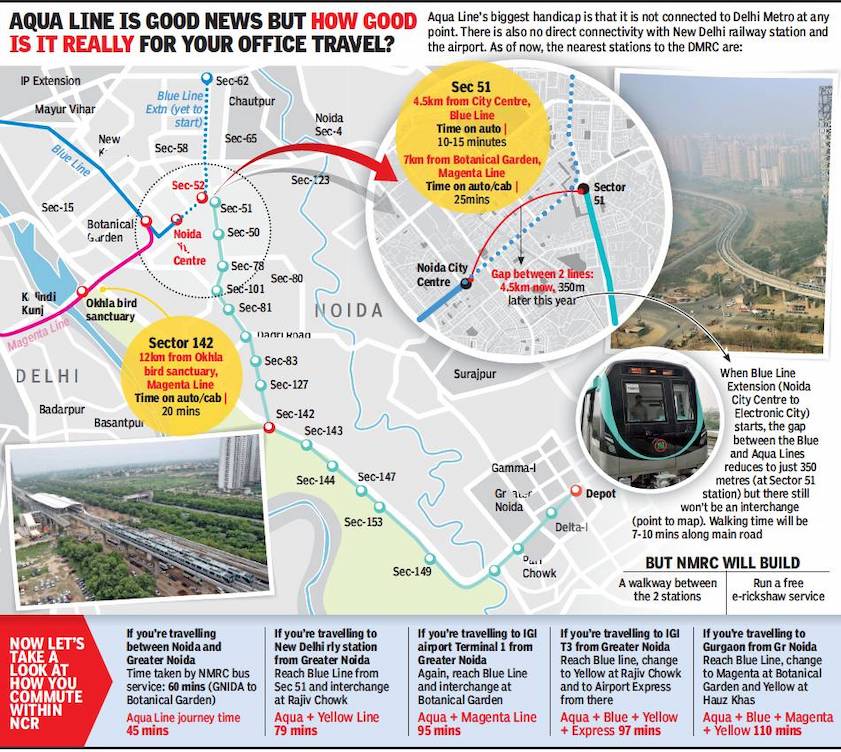NOIDA: Metro
This is a collection of articles archived for the excellence of their content. |
History
2019: Inauguration
Shikha Salaria, Noida to flag off its own metro, January 25, 2019: The Times of India

From: Shikha Salaria, Noida to flag off its own metro, January 25, 2019: The Times of India
No Easy Link Between Blue And Aqua Lines: Nearest Stns 4km Apart, Separate Cards Needed For Travel
The city’s biggest infrastructure project, the 29.7km Noida-Greater Noida Metro line, will be inaugurated on Friday, meeting both its immediate need for a transport network to match the expansion of its urban area and population, and the aspirational necessity of a modern transit system that matches its economic ambitions.
The 21-station network, called the Aqua Line, takes organized public transport to expressway sectors in Noida (though not all of them) for the first time and opens up the gateway to Greater Noida where people have bought houses but hesitated to move because of the absence of fast and reliable public transport. It also reduces commuting time between the twin cities and puts Noida way ahead of Gurgaon in terms of its internal metro connectivity.
But while the Aqua line, which will be flagged off by Yogi Adityanath, fills those important gaps, it still leaves open a crucial one — the lack of an interchange with Delhi Metro, a factor that is likely to have an effect on its ridership. The official launch will take place at 12.30pm and the inaugural train will run from Sector 137 to Depot. But it won’t be a passenger train. Commercial services will begin the next day.
The full journey between Depot and Sector 52 in the four-coach rakes imported from China is expected to take around 45 minutes.
No interchange
Without an interchange station, Aqua Line will be like an island on the Delhi Metro map, very close to the grid but not connected to it. People commuting, say, from Greater Noida to Delhi, Gurgaon, the airport or other parts of NCR will have to get off at Sector 51 (originating station in Noida), take an auto or cab and travel around 4.5km to Noida City Centre for a connection with the Blue Line, or a little further to Botanical Garden to catch a train on the Magenta Line. They will also have to switch to a token or smart card to travel on the Delhi Metro network because there is no ticketing interface between the two lines.
The Aqua Line also gives the Noida Expressway a network of stations, which is good news for the housing projects there. Yet, because of the alignment of the route, which moves diagonally into Noida from the expressway, there is yawning 12km gap with DMRC’s closest expressway station — Okhla Bird Sanctuary on the Magenta Line (from Sector 142, Aqua Line).
The gap between the Blue Line and Aqua Line will, however, reduce to just 350 metres by the middle of the year when the Blue Line extension (Noida City Centre to Electronic City) becomes operational. But there will still be no interchange. The Noida Authority is planning to build a walkway between the Sector 51 station (Aqua Line) and Sector 52 station (Blue Line extension) and a run free erickshaw service to make the transition as smooth as possible. But there is no clarity yet on how that will pan out.
Talk of a skywalk between the two stations has been shot down by the local authorities because of a commercial plot that lies in between. At present, the plan is to have a walkway on the ground between the two stations. NMRC executive director PD Upadhyay said a tender for the walkway has been issued. “Work on the walkway will start soon. A carriageway will be built between the two stations, and free e-rickshaw service will be provided for connectivity,” he said. However, the project will take at least a couple of months to take off.
According to Upadhyay, the skywalk between the two stations hasn’t been written off yet. However, it will be left to be built by anyone who buys the commercial plot of over 10,000 sqm. Interestingly, the two stations have been built with a provision for interchange at the concourse level, said officials. “All it requires is a skywalk or foot overbridge to connect the two stations. The stations already have the provision for concourse level connection otherwise,” an official said.
Different cards, separate checks
But that will still not address the ticketing hurdle. The ticketing system of Aqua Line – which is run by the UP government through Noida Metro Rail Corporation (NMRC) — is different from DMRC’s and there is no clearing house system between the two operators (like it does in case of Rapid Metro in Gurgaon). Security systems of the two corridors are also different, meaning commuters who have already undergone a security check on one corridor will have to undergo another set of checks in the other because security is being handled by two different agencies: CISF for Delhi Metro and UP Police’s PAC for NMRC. So, as of now, switching from Aqua to Blue will involve carrying two sets of cards and paying an auto or cab fare in between.
NMRC claims it has opted for the latest ticketing system, and thus had to change from the one used by DMRC. It has also opted for an open card system, in which the metro card doubles as a cash card and can be used in a taxi, bus or mall in future. NMRC said it opted for this system because the new metro policy mandates a common mobility card.